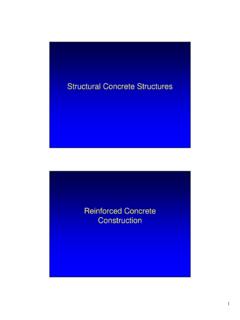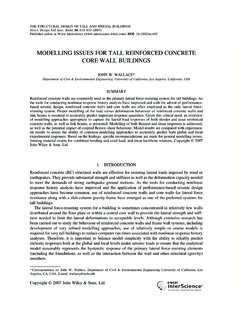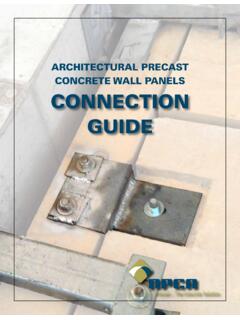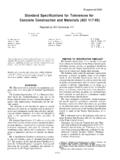Transcription of Design/Construction Guide: Diaphragms and Shear Walls
1 Diaphragms and Shear WallsDESIGN/ construction GUIDEE ngineered wood products are a good choice for the environment. They are manufactured for years of trouble-free, dependable use. They help reduce waste by decreasing disposal costs and product damage. Wood is a renewable, recyclable, biodegradable resource that is easily manufactured into a variety of viable few facts about wood. We re growing more wood every day. Forests fully cover one-third of the United States and one-half of Canada s land mass. American landowners plant more than two billion trees every year. In addition, millions of trees seed naturally. The forest products industry, which comprises about 15 percent of forestland ownership, is responsible for 41 percent of replanted forest acreage.
2 That works out to more than one billion trees a year, or about three million trees planted every day. This high rate of replanting accounts for the fact that each year, 27 percent more timber is grown than is harvested. Canada s replanting record shows a fourfold increase in the number of trees planted between 1975 and 1990. Life Cycle Assessment shows wood is the greenest building product. A 2004 Consortium for Research on Renewable Industrial Materials (CORRIM) study gave scientific validation to the strength of wood as a green building product. In examining building products life cycles from extraction of the raw material to demolition of the building at the end of its long lifespan CORRIM found that wood was better for the environment than steel or concrete in terms of embodied energy, global warming potential, air emissions, water emissions and solid waste production.
3 For the complete details of the report, visit Manufacturing wood is energy efficient. Wood products made up 47 percent of all industrial raw materials manufactured in the United States, yet consumed only 4 percent of the energy needed to manufacture all industrial raw materials, according to a 1987 study. Good news for a healthy planet. For every ton of wood grown, a young forest produces tons of oxygen and absorbs tons of carbon : It s the natural choice for the environment, for design and for strong, lasting Natural ChoiceNOTICE: The recommendations in this guide apply only to products that bear the APA trademark. Only products bearing the APA trademark are subject to the Association s quality auditing SHEATHINGEXPOSURE 1 SIZED FOR SPACING32/16 15/32 INCH000PS 1-07 C-D PRP-108 THE ENGINEEREDWOOD ASSOCIATIONAPA Percent of Percent ofMaterial Production Energy UseWood 47 4 Steel 23 48 Aluminum 2 8 2007 APA THE ENGINEERED WOOD ASSOCIATION ALL RIGHTS RESERVED.
4 ANY COPYING, MODIFICATION, DISTRIBUTION OR OTHER USE OF THIS PUBLICATION OTHER THAN AS EXPRESSLY AUTHORIZED BY APA IS PROHIBITED BY THE COPYRIGHT and Shear WallsForm No. L350A 2007 APA The Engineered Wood Association ..3 Diaphragms AND Shear Walls DEFINED ..4 ADVANTAGES OF diaphragm design ..6 design EXAMPLESE xample 1 .. 9 Example 2 .. 10 Example 3 .. 10 Example 4 .. 12 Example 5 .. 14 Example 6 .. 16 Example 7 .. 18 Example 8 .. 19 Example 9 .. 20 Example 10 .. 22 Example 11 .. 23 Example 12 .. 24 APPENDIX A ..26 APPENDIX B ..27 APPENDIX C .. 30 diaphragm / Shear WALL design REFERENCES ..31 ABOUT APA ..32hen designing a building for lateral loads such as those generated by wind or earthquakes, a design engineer may have several alternatives.
5 Lateral loads may be transferred to the foundation via braced frames or rigid frames, diagonal rods or x bracing, including let-in bracing in the case of wood frame construction , or other methods. Where wood structural panels are used for the roof, floors, or Walls in a building, lateral loads can be accommodated through the use of these ordinary vertical load bearing elements. This type of construction is easily adaptable to conventional light frame construction typically used in residences, apartment buildings and offices. The same concept is equally adaptable to larger warehouses and similar industrial or commercial can be designed to resist the horizontal loads introduced by the most violent wind or earthquake through the application of a principle called diaphragm design .
6 This guide from APA The Engineered Wood Association defines Diaphragms and Shear Walls and gives examples of how they can be incorporated into building and Shear WallsForm No. L350A 2007 APA The Engineered Wood Association AND Shear Walls DEFINEDA diaphragm is a flat structural unit acting like a deep, thin beam. The term diaphragm is usually applied to roofs and floors. A Shear wall, however, is a vertical, cantilevered diaphragm . A diaphragm structure results when a series of such vertical and horizontal Diaphragms are properly tied together to form a structural unit. (See Figure 1.) When Diaphragms and Shear Walls are used in the lateral design of a building, the structural system is termed a box sys-tem.
7 Shear Walls provide reactions for the roof and floor Diaphragms , and transmit the forces into the accurate method for engi-neering Diaphragms has evolved from analytic mod-els and extensive testing, and will allow the engineer to supply his client with a build-ing resistant to hurricanes or earthquakes at very little extra structural design of build-ings using Diaphragms is a rel-atively simple, straightforward process if the engineer keeps in mind the over-all concept of structural diaphragm behavior. Actually, with ordinary good construction practice, any sheathed element in a building adds considerable strength to the structure. Thus, if the Walls and roofs are sheathed with panels and are adequately tied together, and to the foundation, many of the requirements of a diaphragm structure are met.
8 This fact explains the durability of panel-sheathed buildings in hurricane and earthquake conditions even when they have not been engineered as Diaphragms . For full diaphragm design , it is necessary to also analyze chord stresses, connections and tie Diaphragms have been used extensively for roofs, Walls , floors and partitions, for both new construction and rehabilitation of older diaphragm acts in a manner analogous to a deep beam or girder, where the panels act as a web, resisting Shear , while the diaphragm edge members perform the function of flanges, resisting bending stresses. These edge mem-bers are commonly called chords in diaphragm design , and may be joists, ledgers, trusses, bond beams, studs, top plates, wall carries loadto roof diaphragm at top,and to foundation at bottomRoof (horizontal diaphragm )carries load to end wallsEnd wall (vertical diaphragm or Shear wall) carries load to foundationv (lb per lin ft of diaphragm width) =w (lb per lin ft of wall) = FT (lb) = C = vhh2wL2bWind load, (lb per sq ft)FIGURE 1 DISTRIBUTION OF LATERAL LOADS ON BUILDINGD iaphragms and Shear WallsForm No.
9 L350A 2007 APA The Engineered Wood Association Shear wall is simply a cantilevered diaphragm to which load is applied at the top of the wall, and is transmitted out along the bottom of the wall. This creates a potential for overturning which must be accounted for, and any over-turning force is typically resisted by hold-downs or tie-downs, at each end of the Shear to the great depth of most Diaphragms and small span-to-depth ratios in the direction parallel to application of load, and to their means of assembly, their behavior differs slightly from that of the usual, relatively shallow, beam. Shear stresses have been proven essentially uniform across the depth of the diaphragm , rather than showing sig-nificant parabolic distribution as in the web of a beam.
10 Similarly, chords in a diaphragm carry all flange stresses acting in a simple tension and compression, rather than sharing these stresses significantly with the web. As in any beam, consideration must be given to bearing stiffeners, continuity of webs and chords, and to web buckling, which is normally resisted by the framing vary considerably in load-carrying capacity, depending on whether they are blocked or unblocked. Blocking consists of lightweight nailers, usually 2x4s, framed between the joists or other primary structural supports for the specific purpose of connecting the edges of the panels. (See Figure 2.) Systems which provide support fram-ing at all panel edges, such as panelized roofs, are also considered blocked. The reason for blocking in Diaphragms is to allow connection of panels at all edges for better Shear transfer.










